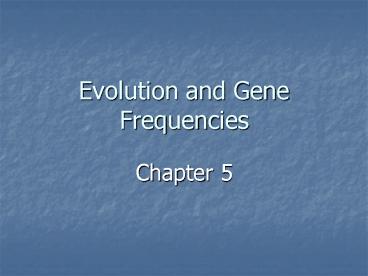Evolution and Gene Frequencies - PowerPoint PPT Presentation
1 / 22
Title:
Evolution and Gene Frequencies
Description:
Groups of individuals of the same species that occupy a given area at the same ... The formation of new species. Reproductive isolation. Population must be isolated ... – PowerPoint PPT presentation
Number of Views:221
Avg rating:3.0/5.0
Title: Evolution and Gene Frequencies
1
Evolution and Gene Frequencies
- Chapter 5
2
Gene Frequencies
- Populations and gene pools
- Populations
- Groups of individuals of the same species that
occupy a given area at the same time and share a
unique set of genes - Allele varying expressions of genes
- Ex. Hair or fur color
3
Gene Frequencies
- Gene pool the sum of all alleles for all traits
in a sexually reproducing population - Reasons for variation
- Independent assortment
- Crossing-over
- Chance of a particular sperm fertilizing an egg
- Rearrangements of number and structure of
chromosomes - Mutations
4
Gene Frequencies
- Hardy-Weinberg theorem
- The mixing of alleles at meiosis and their
subsequent recombination do not alter the
relative frequencies of the alleles in future
generations - Requires that certain assumptions be met
5
Gene Frequencies
- Assumptions
- Population size must be large
- Sexual reproduction in the population must be
random - Migration can not occur
- Mutations must not occur
6
Gene Frequencies
- Evolutionary mechanism
- Evolution is not bad, nor goodit is just a fact
- Evolution is a result of some individuals in a
population surviving and being more effective at
reproducing than others in the population
(Fitness) - This leads to changes in the allelic frequency,
which is the definition of - EVOLUTION!
7
Gene Frequencies
- Population size
- The smaller the size the more significance chance
may be - Survival may not be because of being the best,
but because of chance
8
Gene Frequencies
- Genetic Drift
- Chance events influencing the frequencies of
genes in populations Neutral Evolution - Flipping a coin
- Founder Effect
- When individuals from a group colonize new
habitats - Seldom carry the same allelic frequencies
- New colony is likely to have distinctive genetic
makeup
9
Gene Frequencies
- Bottleneck effect
- Example of the Founder Effect
- Population becomes very small and reduces the
amount of variation - Traditional view bottlenecks decrease the
genetic variation and makes the species less
likely to withstand environmental stresses - Populations with high diversity are likely to
have individuals with genes that allow them to
withstand environmental pressure
10
Gene Frequencies
- Neutral evolution
- When gene frequencies change independently of
natural selection - These changes do not affect the fitness of the
organisms
11
Gene Frequencies
- Gene Flow
- Changes in relative allele frequency from the
migration of individuals (Evolution) - Immigrate
- Individuals enter a population from the outside
- Emigrate
- Individuals leave a population
- Can result in the separation of one species into
two different species
12
Gene Frequencies
- Mutation
- Changes in the structure of genes and chromosomes
- Mutations are a fact of life
- Source of variation
- Origin of all new alleles
- Make extinction less likely
- Most are harmful
13
Gene Frequencies
- Modes of selection
- Directional selection
- When one extreme phenotypic group of individuals
within a species are at a disadvantage to the
other extreme - Bad allele becomes extinct
- Peppered Moths
14
(No Transcript)
15
Gene Frequencies
- Disruptive selection
- Selection in which individuals in the middle of
the range of phenotypes is selected against or
will become extinct
16
Gene Frequencies
- Stabilizing selection
- When the two extreme phenotypes are not an
advantage.
17
Gene Frequencies
- Polymorphism
- Two or more distinct forms with no forms in
between - Balanced polymorphism
- Maintaining each distinct form at about the same
amount
18
Gene Frequencies
- Species
- A group of populations in which genes are
actually, or potentially, exchanged through
interbreeding
19
Gene Frequencies
- Speciation
- The formation of new species
- Reproductive isolation
- Population must be isolated
- Premating isolation
- Prevents mating from taking place
- Temporal isolation
- Behavioral isolation
- Postmating isolation
- Prevents successful fertilization and development
even though mating has occurred
20
Gene Frequencies
- Allopatric speciation
- When subpopulations become geographically
isolated - Most common form of speciation
- Also results in adaptive radiation
- Ex. Gallapgos finches
21
Gene Frequencies
- Parapatric speciation
- Speciation in a small, local population
- Demes
22
Gene Frequencies
- Sympatric speciation
- Speciation that occurs in populations that have
overlapping ranges































